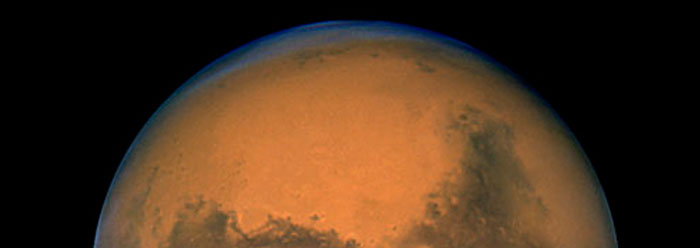In the 1980's and 90's, considerable emphasis has been placed upon climate and environmental issues in the United States. Much air pollution legislation has been put into force. Long-range climate trends have been observed and predicted. Dire scenarios of dramatic warming with attendant droughts and coastal flooding have been predicted. At the same time, devastating displacements of population centers and agricultural consequences due to a possible new "Ice Age" have been presented to the public by other experts.
It seems that the scientific establishment and news media have reached a level of hyperactivity, or even paranoia. Why has this recent flurry of concern developed in the environmental sciences? This article will attempt to show that one underlying reason has been the interpretation of climate history by uniformitarian processes over millions of years, rather than by catastrophic processes over thousands of years. An explanation of climatic phenomena by uniformitarian processes requires inherent instabilities in the earth/atmosphere system which are thought to be triggered by small, initial impulses. Fear of triggering such an instability has led to an unreasonable regulation of possible pollutants.
The current most popular explanation for the "Ice Ages" is based on a refinement of a theory first proposed by Milankovitch.[1] This explanation suggests that the slight changes in orientation and distance from the sun, which the earth experiences in its orbit, result in small variations in heating of the earth's atmosphere. When the heating is reduced, an "Ice Age" occurs, and when it is increased, the excess ice melts and an "interglacial period" results.
 Figure 1 shows the earth in orbit around the sun. Everyone is familiar with the dramatic changes in heating by the sun as the earth rotates daily on its axis, causing daytime heating and night-time cooling. Not quite as well understood by many is the annual change in seasons as the earth revolves around the sun. Because the earth's axis of rotation is tilted by 23.5 degrees from the normal to the plane of its path around the sun, the northern hemisphere is inclined toward the sun during its summer and away from the sun during its winter. This causes greater heating and warmer temperatures in summer than winter. The southern hemisphere experiences the same effect but is six months out of phase with the northern hemisphere. The period of the earth's rotation on its axis is approximately 24 hours, and the period of Earth's revolution around the sun is approximately one year.
Figure 1 shows the earth in orbit around the sun. Everyone is familiar with the dramatic changes in heating by the sun as the earth rotates daily on its axis, causing daytime heating and night-time cooling. Not quite as well understood by many is the annual change in seasons as the earth revolves around the sun. Because the earth's axis of rotation is tilted by 23.5 degrees from the normal to the plane of its path around the sun, the northern hemisphere is inclined toward the sun during its summer and away from the sun during its winter. This causes greater heating and warmer temperatures in summer than winter. The southern hemisphere experiences the same effect but is six months out of phase with the northern hemisphere. The period of the earth's rotation on its axis is approximately 24 hours, and the period of Earth's revolution around the sun is approximately one year.
Other harmonic variations occur in the orbit of the earth around the sun which are familiar to only a few specialists. The earth experiences a slight wobble as it rotates on its axis. This wobble, caused by the gravitational attraction between a slightly non-spherical Earth and the sun, moon, and planets, has a period of about 20,000 years. By this it is meant that the small, episodic changes measurable today imply a cycle of 20,000 years from maximum to maximum. In addition, the precession of the equinoxes (the migration of the positions of the axes of the elliptic path of the earth around the sun) also has a period of about 20,000 years. The angle of the earth's axial tilt varies between 22 and 24 degrees with a period of about 40,000 years. Another fluctuation is a 100,000 year periodic change in the eccentricity of the annual orbit from circular to elliptic and back again. Each of these small periodic changes, if allowed to experience a full cycle, would cause a small change in heating of the earth's atmosphere.
When the periods of these orbital parameters were compared to the fluctuations in ice sheets and sea-floor sediment, thought to have been deposited over millions of years, a correlation was found. Spectral analysis of about a dozen sea-floor sediment cores in the equatorial Pacific Ocean found peaks at 19,000, 23,000, 41,000, and 100,000 years. The first three peaks matched the periods for wobble, precession, and tilt which most strongly affect solar heating. However, the strongest cycle in the sediment record occurred at 100,000 years which corresponds to the period of the eccentricity, the weakest influence on solar heating. Because of this correlation, many paleoclimatologists believe the Astronomical Theory has been proven. Nevertheless, several major weaknesses in the theory remain.
The long-period elements of the earth's orbit—wobble, precession, tilt, and eccentricity—influence the solar radiation received, particularly in its geographical distribution. However, the total heating due to solar radiation, integrated over the entire globe annually, only varies significantly with eccentricity. Since the total heating due to eccentricity varies by less than 0.2%, a major task therefore has been to show that this small change in heating (in fact, the smallest periodic fluctuation in solar heating) could lead to cyclic glaciation of the earth on the order of 100,000 years.
The climatic state of the earth is not a simple function of total solar heating. It also appears to be dependent on the distribution by latitude. The earth modulates solar heating by reflection, retention, and redistribution of received energy. A complete theory for the interaction of these effects has not been developed.
Because confidence is so high in the statistical basis of the Astronomical Theory as an explanation for the "Ice Ages," the problems of a small amount of heating due to changes in eccentricity and a lack of a complete physical explanation for climate change has not led to abandonment of the theory. Instead, an assumed secondary feedback mechanism of some type has been hypothesized for "Ice Age" initiation. In other words, a small cooling pulse due to a periodic decrease in solar heating from changes in the orbital parameters triggers some unknown physical mechanism in the earth-atmosphere system which leads to an "Ice Age."
The implication of this approach is that the earth-atmosphere system is inherently unstable, and a small perturbation can create massive changes in the climate. Investigators have attempted to show evidence for past climate instabilities using recent ice core results from the Greenland Ice Core Project (GRIP), but later data from the Greenland Ice Sheet Project (GISP) invalidated this interpretation.[3] [4] Extreme temperature fluctuations before the last "Ice Age" found in the GRIP ice core were not present in the GISP ice core. Evidence for climate instability continues to elude researchers.
The connection between climate and fluctuations in solar heating due to orbital variations is an assumption, not a proven mechanism and has led to the wild speculations seen frequently in both technical and popular literature. If a trigger for "Ice Ages" truly exists in our earth-atmosphere system, then we should obviously be very careful not to do anything which could release the trigger. An inadvertent release of such a trigger could lead to possible chaotic weather conditions, flooding, and drought. Under such conditions we should obviously restrict the release of pollutants into the atmosphere like smokes and particulates which are known to produce cooling. However, the assumption of a trigger does not necessarily mean that one exists. In fact, much evidence suggests that the atmosphere is a very stable system,[5] and catastrophic events are required to cause climatic changes as massive as an "Ice Age."
I believe the assumption of a trigger is the result of unjustified confidence in the Astronomical Theory which, in turn, is based on uniformitarian processes over millions of years. The current research which is being conducted at ICR [6] is beginning to demonstrate that the events of the Genesis Flood would naturally produce an "Ice Age." The residual heat remaining in the oceans after the Flood would release tremendous quantities of moisture and fall as snow in the polar regions and on mountains for several hundred years after the Flood. If ice sheets and layers of sea-floor sediments were not laid down slowly over long periods of time, but rapidly over the last few thousand years following the global Flood described in Genesis, then the Astronomical Theory is completely wrong. If the Astronomical Theory is wrong, there is no need for a trigger, and the concern for a fragile, unstable atmosphere which can suddenly revert to a new "Ice Age" is unjustified.
- Milankovitch, M., 1930. "Mathematische klimalehre und astronomische theorie der Klimaschwankungen." in: Handbuch der Klimatologie, I.W. Koppen and R. Geiger (Eds.), Gebruder Bontraeger, Berlin.
- Berger, A., S.H. Schneider, and J.C. Duplessy, eds., 1989. "Oceanic Response to Orbital Forcing in the Late Quaternary: Observational and Experimental Strategies," in: Climate and the Geosciences, Kluwer Academic Publishers, Dordrecht.
- GRIP (Greenland Ice Core Project) Members, 1993. "Climate instability during the last interglacial period recorded in the GRIP ice core," Nature, Vol. 364, p. 203.
- Grootes, P.M., M. Stuiver, J.W.C. White, S. Johnsen, and J. Jouzel, 1993. "Comparison of oxygen isotope records from the GISP2 and GRIP Greenland ice cores," Nature, Vol. 366, p. 552.
- "Statement by the Science and Environmental Policy Project," 1992. A group of atmospheric scientists publicly expressed concerns about plans to impose global environmental regulations on national governments. They stated that highly uncertain scientific theories derived from theoretical climate models have not been validated by the existing climate records and do not justify the actions being considered at this time. In: The New American, June, 1992, p. 9.
- Vardiman, L., 1993. Ice Cores and the Age of the Earth. Institute for Creation Research Monograph, San Diego, CA.
* Dr. Vardiman is Chairman of the Astro/Geophysics Department at I.C.R.


















